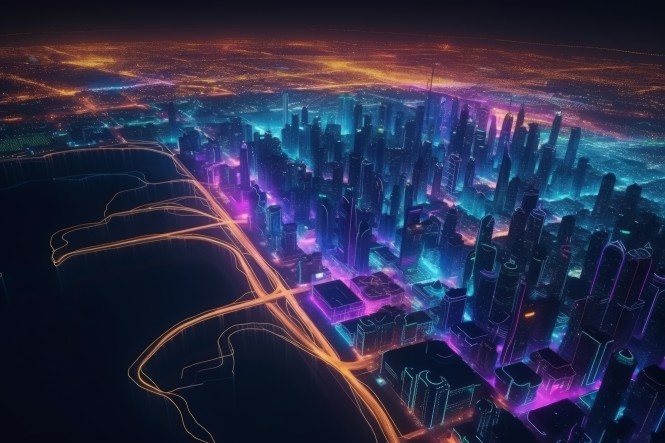
Once upon a skyline, buildings just stood. Now, they listen, learn, and speak.
As we approach the edge of a hyper-connected era, our cities are evolving into living, breathing systems. From streets that feel your steps to buildings that power themselves, architecture is no longer the art of construction—it’s becoming the architecture of intelligence.
Welcome to the Smart City era—where architecture becomes digital.
The Digital Dawn of Architecture
Not too long ago, architectural design went no further than CAD drawings and BIM models. Nowadays, sensors, AI, and IoT (Internet of Things) have made our buildings data-rich organisms. In smart cities, the distinction between physical structure and digital system is disappearing rapidly.
Imagine a traditional building as a stone sculpture—immovable, aesthetically pleasing, but passive.
Now imagine a smart building as a symphony—dynamic, adaptive, attuned to its surroundings, and continuously fine-tuning its rhythms.
What is a Smart City, exactly?
A Smart City leverages technology and information to boost residents’ quality of life, simplify urban operations, and encourage sustainability. That means smart transportation networks, green infrastructure, responsive public spaces, and smart buildings.
At the centre of it all? Architects.
Because before a city can be smart, it first needs to be well-designed.
The Architect as a Digital Composer
Architects in smart cities are not only designing spaces—they’re writing scripts for behaviours.
- Walls become interfaces.
- Windows respond to weather.
- Streets read foot traffic.
The architect’s palette now involves data layers, sensor networks, and real-time analytics. Picture designing a façade that not only shades a building but also harvests solar energy, cleans air, and reports its performance in real time.
This transition requires a new kind of fluency—a digital literacy.
For architecture students, this is the invitation to be digital designers, not merely structural artists.
Case Studies: The Smart Blueprint
- The Edge, Amsterdam
The Edge has been called the “smartest building in the world.” It employs more than 30,000 sensors to track lighting, temperature, occupancy, and even usage of coffee machines. The building adapts itself depending on who occupies it and when.
Takeaway: Architecture isn’t just occupied—it’s responsive.
- Songdo, South Korea
A smart city master planned from the ground up, where buildings communicate with transit systems and citizens use a single smart card for all activities—opening doors to homes to buying lunch.
Takeaway: Planning cities + technology = living connected.
- Sidewalk Toronto (Alphabet/Google project)
A dream of wooden high-rises, modular construction, and streets that clear snow with heated sidewalks. Although the project was shelved, its conceptual scope remains gargantuan.
Takeaway: Experimental concepts are even changing architectural standards.
Key Technologies Redefining Architecture
Artificial Intelligence (AI)
AI assists architects in maximizing form, function, and environmental performance during the design process. AI-informed design software such as Autodesk’s Space maker indicates optimum layouts for sunlight, noise, and wind.
Internet of Things (IoT)
Smart sensors installed in buildings collect data in real-time—on energy consumption, occupancy, temperature, and air quality—and feedback into building management systems.
Parametric Design + BIM 5D/6D
Building Information Modelling (BIM) is now augmented with real-time cost (5D), sustainability information (6D), and lifecycle management. Added with parametric design, it provides unprecedented control over intricate geometries and performance.
Digital Twins
Envision a living 3D digital copy of a building or city. Digital twins reflect real-time information and can replicate anything from traffic to energy usage, allowing architects to see how a building will operate before it’s constructed.
Challenges on the Smart Road
Smart doesn’t mean perfect.
- Privacy issues (Who owns the data your home is gathering?)
- Digital equity (Are smart cities for everyone?)
- Complexity (How do architects stay current with ever-changing tech?)
To create intelligent, we have to create responsibly, with ethics and inclusion driving our digital designs.
The Future Studio: How Architects Need to Change
The future architecture studio is less drafting room and more hybrid laboratory:
- One side drawing with tablets and AR goggles.
- The other side programming behaviour into façades.
- Working together with data scientists, urban ecologists, and AI engineers.
For students of architecture, the message is clear: adopt interdisciplinary learning. Coding, systems thinking, and UX design are as important as material science and architectural history.
Conclusion: The city as a Living Story
Smart cities are more than technological wonders—they are stories waiting to be told.
Each pixel-lit park, each energy-generating rooftop, each data-driven crosswalk is part of a story where architecture is no longer static frame, but dynamic plot.
And you—the architect—are more than a builder. You’re a digital storyteller. One who designs how people live, move, connect, and dream in the cities of the future.
